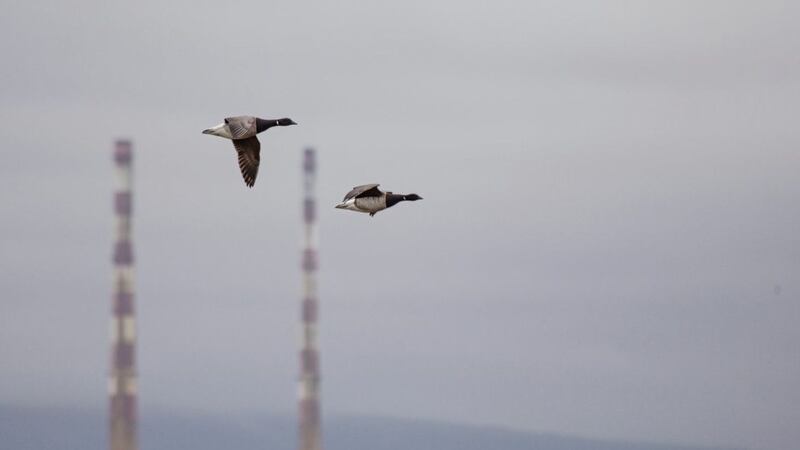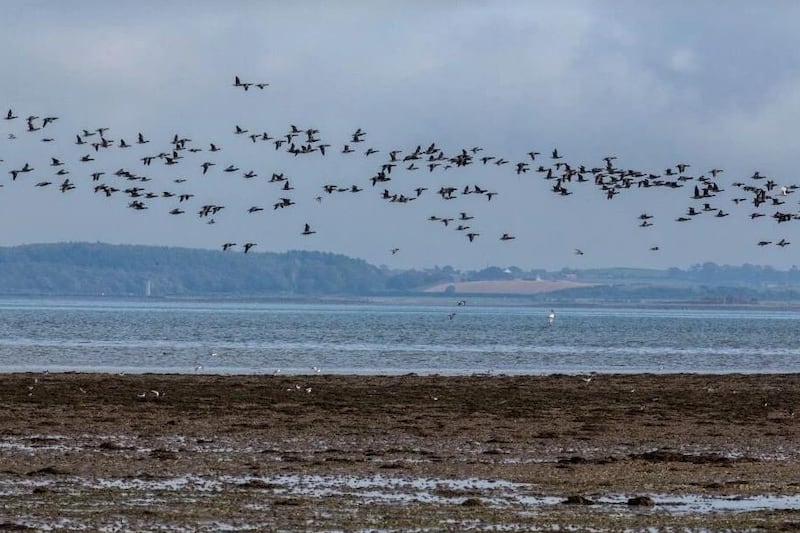PASSING through Bundoran, Co Donegal, recently, I saw a small flock of brent geese, Branta bernicla hrota, feeding at low tide, in the bay beyond the bridge, where the River Bradog flows into the Atlantic, the place which also marks the crossing point to the west end of the town.
Interestingly, the town’s name ‘Bun Dobhráin’, Irish for the ‘foot of the little water’ has its origins at this spot as the bridge once marked the border between two villages, Bundoran to the west and Single street to the east. It was only after the opening of the railway station in 1866 that the two towns and communities merged to become what we today call Bundoran.
These light or pale-bellied brent geese are winter migrants from high Arctic Canada and Greenland, this population (upwards of 30 000 – Birdwatch Ireland), winter almost entirely in Ireland with some small numbers visiting parts of Britain and France.
They occur around our coastal estuaries from October to April, feeding mostly on eel grass and other vegetation. Highest numbers are seen at Strangford Lough where they congregate on arrival before dispersing to other sites such as Lough Foyle, Dublin Bay, Tralee Bay and Wexford Harbour and Slobs. Its close relative the dark-bellied brent is a much rarer winter visitor.
The brent is a small, chunky dark goose with a black head, neck and breast, dark brown upperparts and a pale belly. Adults have a small white crescent neck patch. It is thought ‘brent’ comes from the Norse word ‘brand’ meaning burnt and was given to the bird because of its charcoal like colour. Its generic bernicla means ‘barnacle’, a larger relative (Barnacle goose) with which it has often been confused.
The brent’s Irish name, cadhan, is also sometimes used for the barnacle goose. Brent geese nest on the boggy Arctic tundra, where the breeding season is short. By mid-September, they begin their migration to our shores, flying in family groups, in V-formation and travelling mostly at night.
Ancient tales reveal that brent geese were eaten in early Irish society. In the Cattle Raid of Cooley, Cúchulainn welcomes the warrior Lugaid, telling him that ‘‘if birds fly over Mag Murthemne you shall have a brent goose (caud) and a half’’ as a token of hospitality. Intriguing stories also persisted about the bird-fish myth around the black geese, the barnacle and brent.
In early centuries, it was believed that both geese were types of shellfish, born on old timber on the sea floor.
‘Goose barnacle’ shellfish resemble the head and beak of the barnacle goose especially, hence its name. The first authoritative account of this was by Geraldus Cambrensis, or Gerald of Wales as he became known, a Norman monk who wrote his famous Topographia Hibernica, around 1186, an influential work on the landscape and people of Ireland.
On the barnacle goose he wrote that, "they hang their beaks from what seems like sea-weed clinging to the log, while their bodies, to allow for their more unimpeded development, are enclosed in shells. He concludes, ‘‘Accordingly, in some parts of Ireland bishops and religious men eat them without sin during a fasting time, regarding them as not being flesh, since they were not born of flesh.’’ (Translated by John O’ Meara 1982.)
By 1215, however, Pope Innocent III issued a Papal Bull (a public decree by the Pope, named after the leaden seal (bulla) traditionally used to authenticate it) which forbade the eating of barnacle and brent geese during Lent and Fridays.
‘Fish or fowl’, the attractive brent goose remains a welcome visitor to our shores.






